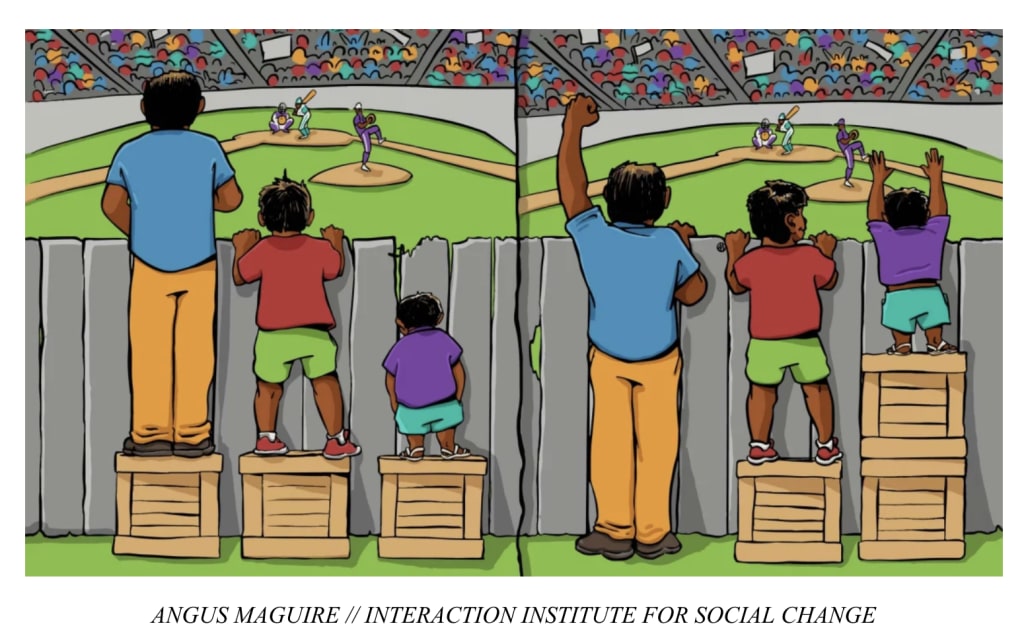Equity is the New Equality
It’s time to change the narrative.

Throughout history, Black people have been fighting for equality, even to this day. But, what if equality is not enough? What if we need something more? Could it be equity? Before taking a deep dive into this, let’s take a swim in the kitty pool and look at the definitions of equality and equity. According to Merriam-Webster, equality is the state and quality of being equal. Being equal means of the same measure, quantity, amount, or number as another. On the other hand, equity means justice according to natural law or right; specifically: freedom from bias or favoritism. The Milken Institute School of Public Health states the following: “Equality means each individual or group of people is given the same resources or opportunities. Equity recognizes that each person has different circumstances and allocates the exact resources and opportunities needed to reach an equal outcome.”
Now hold up, so Black people have been fighting for equity, but called it equality? That’s a huge problem, however, it’s not their fault. They have been misinformed most of their lives, that equality is synonymous with justice. The dominant society disenfranchised them for over decades with misinformation of knowledge, miscommunication of action, and misappropriating funds to create poverty. Fast forward to now thanks to the internet, we have the opportunity to dispel these myths and become well informed about the world around us.
“In America, you gotta work twice as hard [as white folks] to get half as much.” -Black Proverb
This proverb holds true within the Black community since (the Reconstruction era after the Civil War) until now, where in many Black households, parents advised their children of the harsh realities of the world we currently live in. Frankly, economics and education are the two major areas of activity affected the most.
No one can expect an equal outcome by giving everyone the same amount of resources while everyone has different circumstances, especially in economic situations. According to a CNBC article, these four factors contribute to the racial economic disparity. The four factors are homeownership, stocks, net worth, and student debt. “It is hard to imagine significantly improving the lives of Black Americans and addressing our long history of racism without a commitment to reduce extreme wealth inequality,” Allen MacNeill said, a professor at Webster University.
With education, the disparity lies within the funding of schools in poor and rich areas. A New York Times article reports that wealthier districts fund their schools with local property tax revenue, while poorer districts are unable to generate the same revenue. School districts are generally funded locally, but states are supposed to “fill in the gaps'' so communities are evenly funded despite wealth disparities, Rebecca Sibilia said, the chief executive of EdBuild, a nonpartisan organization focused on improving the way states fund public education. The report showed that in many states, “they are not keeping up with their own obligation,” she said. It shows that non-white school districts receive $23 billion less than white districts despite serving the same number of students. Despite Brown v. Board of Education, the gap is still wide and being invested into rich, white communities.
Image Source: Safehouse Progressive Alliance for Nonviolence (2005). Adapted: Ellen Tuzzolo (2016); Mary Julia Cooksey Cordero (2019); The Conscious Kid (2020).
As far as solutions are concerned, this article stated the following, “For example, one solution is to reduce racial disparities in the criminal justice system and provide opportunities for formerly incarcerated individuals. Another is to instill workforce development programs with equity initiatives in order to address structural barriers in the labor market. Finally, policymakers need to allocate more resources toward enforcing and strengthening existing civil rights laws. The unemployment gap between African Americans and whites has persisted for nearly 50 years; policymakers need to address it before the economy can ever truly be at full employment.”
Lastly, four out of the ten solutions discussed in this report were to bridge the racial wealth gap by investing in baby bonds, investing in affordable housing, raising taxes on the wealthy, and improving data collection on race and wealth. Ultimately, there must be a collective and generational effort for everyone to achieve an equal outcome. In order to obtain that goal is to give the exact resources that are needed, instead of giving the same things to everyone else, especially if a group of people were disenfranchised for four centuries.
About the Creator
Tyler Williams
A writer that empowers people through inspiring and informative articles.






Comments
There are no comments for this story
Be the first to respond and start the conversation.